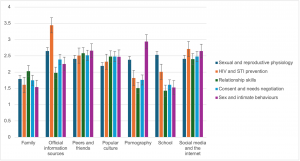Think back to sex ed class (if you had one). Now imagine that class, but remove all mentions of anything beyond straight relationships. For some of you, that might not require any imagination.
For many sexual minority men (gay, bisexual, and other men who have sex with men), traditional sex and relationship education leaves a lot to be desired. Our recent survey of over 900 sexual minority men across Australia shows just how out of touch these sources can be—and the surprising ways people fill those gaps.
So, What Did We Do?
We asked sexual minority men—who ranged from 18 to 88 years old—to rate the usefulness of different sources of sex and relationship education. These included the usual suspects, like school programs, family, and friends and peers. We also threw in some more modern sources like social media and the internet, popular culture, pornography, and official information from public health sources. The idea was simple: understand how helpful these sources really are for topics that matter, like HIV and STI prevention, relationship skills, consent, and intimacy.
What Did We Find?
Across the board, every source of sex and relationship education was rated as low to moderate in usefulness. Here’s the rundown:
- Schools and Families: No surprise here—these traditional sex education sources rated the lowest. Many men in our study felt these sources either glossed over or ignored issues that matter in their lives, like relationship skills, consent, and intimacy. But school does seem to cover sexual and reproductive anatomy somewhat.
- Peers, Friends, Social Media and the Internet: These sources were a bit better for relationship skills, but even friends can only take you so far. Social media and the internet was also somewhat useful, though there’s always the risk of bad information or questionable advice.
- Official Information Sources: When it came to topics like HIV and STI prevention, health services and public campaigns did get higher marks. These sources have made big strides in promoting safer sex practices among sexual minority men. But for everything else—like learning about intimacy, communication, and consent—they still fell short.
- Pornography: This one’s interesting. Porn was rated as useful for learning about sexual behaviours, like techniques and positions. However, it wasn’t helpful for learning about healthy relationships or consent, as you might expect. Watching something on screen doesn’t exactly teach you how to communicate with a partner in real life.
Figure 1. Perceived usefulness of each sex and relationship education topic by source.
We also found that apart from pornography, older participants rated nearly all sources as less useful compared to younger men. This could suggest that the ways different age groups access and value information vary greatly. Older men may have had fewer inclusive resources available in their youth, which could impact their trust in these sources.
So, What’s the Takeaway?
The biggest takeaway? Most sex and relationship education sources aren’t covering all the bases for sexual minority men. Schools and families often don’t seem to address same-sex relationships enough (if at all). And while friends, social media, and even porn may appear to fill in some gaps, they’re not giving the whole picture, especially when it comes to building healthy, fulfilling relationships.
Why Does This Matter?
For a lot of people, sex and relationships education is one of the first places they learn about relationships, consent, and intimacy. When these early lessons don’t resonate or feel inclusive, it’s easy for sexual minority men to feel left out—or worse, to lack the guidance they need to make informed decisions. Sure, friends and the internet can help, but this isn’t always reliable or comprehensive education.
Imagine going through life learning about relationships, intimacy, and consent from sporadic online articles, snippets from friends, or random bits of pop culture. That’s where many sexual minority men seem to find themselves today.
What’s Next?
These results make one thing clear: in the eyes of sexual minority men, sex and relationship education needs an upgrade. We need programs that are tailored to include the experiences of sexual minority men—something that speaks to their lives. Topics like relationship skills, intimacy, consent, and HIV prevention all deserve attention, and they should be addressed in ways that don’t make people feel left out or unrepresented.
This study shows that while we’re making strides, there’s a lot more to be done. Our next steps as researchers—and hopefully as educators and public health experts, too—should involve finding out what actually works and how we can give everyone, regardless of sexual orientation, the tools to build healthy, fulfilling relationships.
Our study is available to read online in Sex Education for free.
James Newton is a PhD candidate at the University of Queensland, focusing on the intersections of mental health, social policy, and sexual health education. With over 15 years of experience in clinical and community mental health, James currently leads safety and quality initiatives at a non-government mental health service provider, shaping safe, high-quality mental health services. He’s also an accredited Clinical Social Worker with the Australian Association of Social Workers. Follow him on Twitter [@jamesnewton87], ResearchGate, or LinkedIn.


Comments